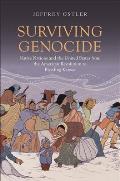“There was an intention to extirpate them”?
At the Age of Revolutions blog, Jeffrey Ostler discusses how American Whigs’ fear of being “enslaved” or subjugated by the British Crown at the start of the Revolutionary War was mirrored by Native nations’ fears of being wiped out by settlers.
He starts with a report of a gathering of Native leaders at the central Cherokee town of Chota:
Folks around here might quibble with Ostler’s description of the 1778 Fort Pitt Treaty as the first between the U.S. and a Native nation. The Treaty of Watertown, negotiated by the state of Massachusetts on behalf of the Continental Congress, was finalized in July 1776. But that was so early the Congress hadn’t yet set up a formal process for treaty negotiation and ratification, and it often escapes notice.
He starts with a report of a gathering of Native leaders at the central Cherokee town of Chota:
Taking a wampum belt in hand, the Shawnee spoke of a long history of injustice at the hands of the “Virginians,” a term many Native people applied to greedy settlers from Virginia and other colonies. The “red people,” he said, had once been “Masters of the whole Country,” but now they “hardly possessed ground enough to stand on.” Not only did the Virginians want their land, the Shawnee contended, they wanted their lives. It is “plain,” he said, that “there was an intention to extirpate them.” Although the term genocide had not been invented, this is precisely what the Shawnee feared Native people were up against: a project that threatened their very existence. . . .Of course, the U.S. of A. didn’t create a state for Native citizens, and it took much of the territory that early treaties reserved for Indians. Whigs’ fear of “slavery” has been recognized as overblown—a tone-deaf metaphor that got out of hand. Natives’ fears of being pushed off their land and extirpated were unfortunately much more prescient.
As I was researching my recent book, Surviving Genocide, I found several examples of what I call “an Indigenous consciousness of genocide.” In March 1776, for example, a Cherokee leader named Dragging Canoe told a British agent that his nation “had but a small spot of ground left to stand upon” and that the colonists’ unrelenting demands for land proved that it was their “Intention…to destroy [the Cherokees] from being a people.”
Three years later, as the Continental Army was about to invade Iroquoia, the homeland of the Six Nations (Haudenosaunees), Mohawk leader Joseph Brant wrote of his “determination to fight the Bostonians,” another designation for rapacious colonists, observing that “it is their intention to exterminate the people of the Longhouse.”
I also discovered that U.S. officials were well aware that Native people were making allegations like those of Dragging Canoe and Joseph Brant. Evidence of their knowledge was sitting in plain sight in the first written treaty between the United States and an Indian nation—the 1778 Fort Pitt Treaty with the Delaware Nation. Article 6 of the treaty addresses the charge that “it is the design of the [United] States…to extirpate the Indians and take possession of their country.” The text, which U.S. commissioners wrote, attributes this allegation to the “enemies of the United States” (i.e., the British), who “have endeavored by every artifice in their power” to convince the Indians of this “false suggestion,” as if Native people wouldn’t have arrived at this conclusion on their own. To convince the Delawares of U.S. benevolence, the treaty promises to guarantee Delaware rights to their lands and offers to consider creating a fourteenth state for Indians.
Folks around here might quibble with Ostler’s description of the 1778 Fort Pitt Treaty as the first between the U.S. and a Native nation. The Treaty of Watertown, negotiated by the state of Massachusetts on behalf of the Continental Congress, was finalized in July 1776. But that was so early the Congress hadn’t yet set up a formal process for treaty negotiation and ratification, and it often escapes notice.


No comments:
Post a Comment